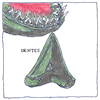Nicolas Steno
stratigraphy

|
Stratigraphy
To explain how a shark’s tooth had the same shape as fossils known as glossopetræ, “tongue-stones,” Niels Stensen, known as Nicolas Steno, took a year to study how fossils could be derived from living things, embedded in stone, and raised up into mountains. Fabio Colonna had established that glossopetræ had organic origins; Steno explained how this happened and extended this by describing how sedimentary rocks formed in layers, were broken, tilted, covered, and uplifted.
Principles
I. “At the time when any given stratum was being formed, all the matter resting upon it was fluid, and, therefore, at the time when the lower stratum was being formed, none of the upper strata existed.” II. “Hence it follows that strata, either perpendicular to the horizon or inclined toward it, were at one time parallel to the horizon.” III. “Materials forming any stratum were continuous over the surface of the earth unless some other solid bodies stood in the way.” IV. “If a body or discontinuity cuts across a stratum, it must have formed after that stratum.”
Time and logic
Logic and direct observation were hardly to be expected in Steno’s time; his makes it clear he was a man of genius. Take a close look and work it out one step at a time. Time means nothing; what is logic? Only that each thing must happen before the next.



Nicolas Steno’s four principles of stratigraphy in “Principles” are superposition, original horizontality, lateral continuity, and cross-cutting relationships, according to Michael E. Brookfield. Above, those principles are in his own words as translated by John Garrett Winter.
See also in The book of science:
Readings in wikipedia: